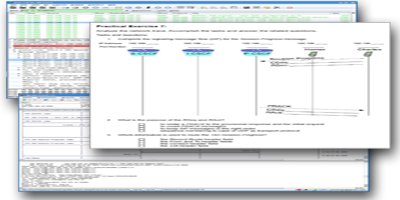 Bootcamp - IMS Signaling Protocols
Bootcamp - IMS Signaling Protocols
(SIP, SDP, DIA, ...)
 Course Description:
Course Description:
- This bootcamp is addressed to everybody who needs to understand the ideas and concepts of an IMS.
- The bootcamp is structured in different sessions with their own key topics. Each sections consists of a theoretical part followed by a practical exercise.
- The bootcamp starts with a general introduction to the IMS and the Open IMS. This includes the used tools (e.g. wireshark as trace analyzer) and the bootcamp workflow.
- The first registration related practical exercise makes the student familiar with the tools and the behavior of the system as well as with the characteristics of the Open IMS.
- The next section covers SIP and SDP especially their protocol structure, tasks and functions. We conclude that section with a review of a call setup.
- The practical part deepens the use of SIP and SDP during the session establishment and shows the used message routing mechanisms within the IMS.
- This section provides the student the theoretical background to understand the a call setup procedure with QoS negotiation between the peers by using the parameters preconditions and 100rel.
- Within this practical exercise the students are forced to recall their knowledge about SIP and SDP.
- The last session relates to the important Application and Service domain. The students will refresh their knowledge about event server and the purpose of the SIP messages PUBLISH, SUBSCRIBE and NOTIFY and the signaling over the ISC interface towards the A&S domain.
- This practical exercise introduces to presence as a service offered by the A&S domain. Furthermore the students analyze a scenario related to an IP TV / VoD service.
 Course Target:
Course Target:
After this bootcamp the student...
- is able to analyze protocol traces taken within the IMS test-system
- has the ability to nail down errors and bugs within an IMS
- has the ability to identify the problem sources
- understands the message flow inside the IMS
- understands the interworking with the common IP-Components (DNS, DHCP)
 Pre-Requisites:
Pre-Requisites:
- This course requires participants to have a very good knowledge of SIP, IMS and IP.
- We advise to visit our classes “SIP, SDP and other NGN Protocols - Signaling & Protocol
Analysis” and “IMS-Architecture Details & System Engineering” before.
 Who should attend:
Who should attend:
- Technicians and Engineers who need the ability to nail down errors within the IMS
- Technicians and Engineers who like to be enabled as practical field staff
 Necessary Equipment:
Necessary Equipment:
- Laptop/PC to take and analyze traces
 Course Contents:
Course Contents:
Theory 1: Network Architecture
- General IMS Network Architecture
- Course-specific Network Structure
- Involvement of the IMS assemblies within the Registration Procedure
- Introduction to wireshark as tracetool
- 3GPP related Registration
Practice 1: Registration related Exercises
- Determination of the general SIP Signaling Message Flow
- Study of the tasks and functions of the Call Session Control Functions
- Analysis of the interworking with the HSS
- Analysis of Diameter Messages at the Cx Interface
- User Identities and their use
- Considerations of the impact of roaming
Theory 2: Call Setup
- SIP Methods and their functions
- Basic Call Setup Procedure
- Provisional Responses
Practice 2: Call Setup and Call Modification studies
- Analysis of the System behavior during Call Setup
- Introduction of Routing Mechanisms
- Call Modification Scenario analysis
- Analysis of Message related Scenarios
Theory 3: SDP and SIP Interworking
- Introduction of SIP Methods PRACK and UPDATE and the SDP parameter for preconditions
- Considerations about Call Setup Scenarios with QoS Negotiating
Practice 3: Extended Call Setup
- Analysis of a Call Setup with QoS Negotiating
- Considerations about required and supported features
Theory 4: Application Server within the IMS
- Use of different AS
- Methods SUBSCRIBE, PUBLISH and NOTIFY
- Communication over the ISC Interface
- HSS involvement and Routing decisions based on Trigger Points
Practice 4: Accessibility of AS over the ISC Interface
- Analysis of the signaling towards a Presence Server
- Considerations about the Tasks and Functions of the X-CSCFs, HSS and the UA
- Examination of the delivery of Presence related information using SIP
- Signaling analysis towards an IP TV / VoD AS
Example of Practical Exercise and Tools

 Related Courses:
Related Courses:
- IMS-Architecture Details & System Engineering
- SIP, SDP and other NGN Protocols - Signaling & Protocol Analysis
 Duration:
Duration:
- 3 days
v1.5
ℹ️ Try out the updated search below!
Search:
Know already our Webinars?
We are proud to introduce the first INACON-Webinars:
- Evolved EDGE in 3 Hours
- DIAMETER in 3 Hours
- GPRS & EGPRS in 3 Hours
- GSM in 3 Hours
- HSPA+ (R7 & R8) in 3 Hours
- IMS in 3 Hours
- IMT Advanced in 90 Minutes
- LTE in 3 Hours
- SAE in 3 Hours
INACON eBooks
Please have a look at our full offer


